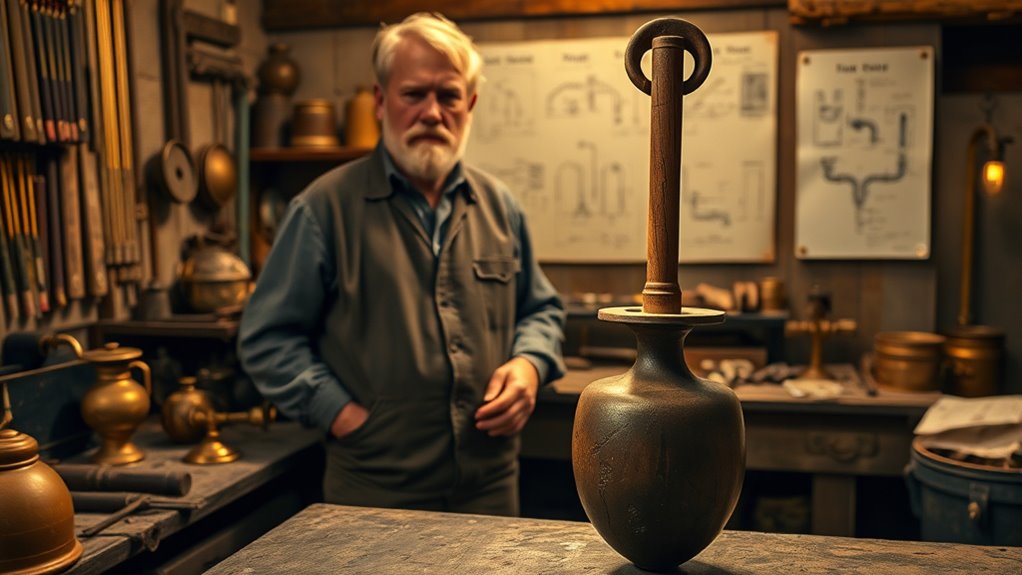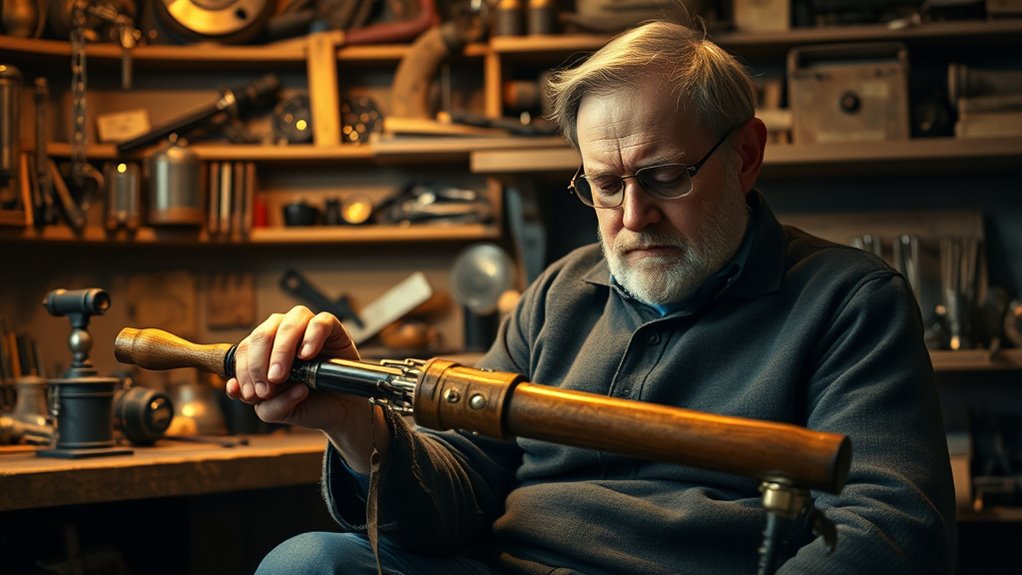Montague Redgrave is credited with inventing the plunger, a simple yet revolutionary tool that transformed plumbing by enabling quick, reliable removal of clogs. His design, featuring a rubber cup attached to a stick, became essential for household and industrial sanitation. This invention marked a key moment in plumbing history, improving hygiene and convenience worldwide. If you continue exploring, you’ll discover how Redgrave’s ingenuity shaped modern sanitation and public health.
Key Takeaways
- Montague Redgrave is credited with inventing the plunger, revolutionizing clog removal.
- His simple rubber cup and stick design transformed plumbing solutions.
- The invention emerged during early toilet innovation periods, influencing sanitation history.
- Redgrave’s creation made clearing blockages quick, reliable, and less messy.
- The plunger became a symbol of practical ingenuity, shaping modern hygiene practices.

Few inventions have had such a lasting impact on daily life as the plunger, and its origins are rooted in the inventive mind of Montague Redgrave. When you think about toilet innovations, the plunger stands out as a simple yet revolutionary tool that transformed plumbing history. Before its invention, dealing with clogged toilets was a messy, frustrating task that often required calling in a plumber or using dangerous chemicals. Redgrave’s design changed all that, giving everyday people a reliable way to clear blockages quickly and effectively.
Understanding the significance of the plunger means recognizing how it fit into the broader evolution of plumbing technology. Before the plunger, early sanitary systems were primitive, often consisting of basic troughs or rudimentary flush systems that lacked efficiency. Redgrave’s creation arrived during a period when toilet innovations were beginning to emerge, paving the way for modern sanitation. His invention provided a practical solution that could be easily manufactured and widely adopted, making plumbing maintenance less of a hassle. It’s no exaggeration to say that the plunger became a cornerstone of plumbing history, bridging the gap between rudimentary sanitation and today’s advanced systems.
You might not realize it, but your daily routine probably relies on the simple act of using a plunger at some point. Its design is deceptively straightforward—just a rubber cup attached to a stick—but its effectiveness is profound. When you face a clogged toilet, you instinctively reach for the plunger because you know it works. This device has been refined over the years, but its core principles remain unchanged. Its impact on toilet innovations is undeniable; it transformed what used to be a messy, often humiliating task into something manageable and quick. That’s why it’s considered one of the most essential tools in home plumbing kits.
Redgrave’s ingenuity didn’t just improve household convenience; it influenced the entire trajectory of plumbing history. The plunger became a symbol of practical problem-solving, inspiring further innovations in sanitation and plumbing devices. Its success demonstrated how simple ideas could lead to widespread change, encouraging manufacturers and inventors to develop new tools that improved hygiene and efficiency. Today, you benefit from this legacy every time you clear a stubborn clog, thanks to the pioneering work of Montague Redgrave. Moreover, the development of safe, effective toilet sanitation methods has been crucial in improving public health outcomes.
In essence, the plunger’s invention marked a pivotal moment in plumbing history. It reflects a time when inventors like Redgrave recognized the importance of accessible, effective solutions to everyday problems. Now, as you handle plumbing issues, remember that behind this humble tool lies a rich history of innovation that continues to shape our modern sanitation systems.
Frequently Asked Questions
What Inspired Montague Redgrave’s Interest in Plumbing Innovation?
Your curiosity about plumbing innovation stems from a fascination with historical plumbing challenges and solutions. You’re motivated by the desire to improve everyday life through inventive ideas. Montague Redgrave’s interest likely grew as he studied past plumbing issues, inspiring him to create better tools like the plunger. His passion for innovation motivation drives him to find practical, effective answers to plumbing problems that have persisted over time.
How Did Redgrave’s Background Influence the Plunger’s Design?
Your background is like a sturdy foundation for the plunger’s design, shaping its evolution through historical context. You’re influenced by your practical skills and curiosity, which drive you to refine the tool for efficiency. Your experiences help you understand user needs, leading to innovations that blend function and simplicity. This blend of past lessons and personal insight results in a design that stands the test of time, improving daily life.
Were There Any Competing Inventions During Redgrave’s Time?
During Redgrave’s time, there were indeed alternative solutions to clearing blockages, but they weren’t as effective. You might have seen attempts like mechanical tools or chemical remedies. However, these often led to patent disputes and limited success. Redgrave’s design stood out because it was simple, practical, and widely adopted. His invention ultimately overshadowed competing devices, making it the go-to solution for plumbing issues in that era.
What Materials Did Redgrave Originally Use for the First Plunger?
Like a modern-day Da Vinci, Redgrave’s innovations started with simple materials. He originally used rubber for the plunger’s cup, a material chosen for its flexibility and sealing ability. The handle was crafted from wood, providing durability and ease of use. Redgrave’s clever selection of plunger materials reflects his ingenuity, setting the stage for future innovations that would revolutionize household plumbing and make your daily routines smoother.
How Did the Invention Impact Sanitation Practices in That Era?
The invention revolutionized sanitation practices by improving waste management and promoting better public health. You’d see fewer blockages and odors, reducing the spread of disease. The plunger made cleaning and maintaining toilets more effective, encouraging households and businesses to prioritize hygiene. This innovation helped control waste more efficiently, ultimately contributing to healthier communities and lowering the risk of sanitation-related illnesses during that time.
Conclusion
As you consider Montague Redgrave’s story, you realize that the birth of the plunger might be more than just an invention—it’s a symbol of innovation born from necessity. Some believe Redgrave’s design was inspired by earlier plumbing concepts, hinting at a gradual evolution rather than a sudden breakthrough. Whether you see him as the true inventor or a pioneer building on past ideas, one thing’s clear: his work transformed everyday life, proving necessity truly is the mother of invention.









